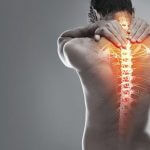Treatment of back pain after surgery

Up to the first three days after surgery, bed rest (partial rest), analgesics, anti-inflammatory and prescribed antibiotics, and wrist straps, belts or soft medical wrists around the clock.
Wound and dressing
In this method, there is no scar or suture, and only a simple adhesive needle is inserted where the patient removes it the next day after surgery and no need for special adhesion or dressing.
Movement
The patient should know that it takes at least 3 weeks for a complete repair of all the parts that were surgically removed during surgery (including muscle, ligament, bone, skin, vascular and nerves). (True, this type of operation is performed without a surgical incision and has a much shorter recovery time, but as with open surgery, the patient must be careful and avoid damaging movements and lifting for some time.)
Important: The first three days are useful for repairing and preventing muscle cramps and spasms, so the patient should have a three-day rest at home, meaning he can only get out of his urine or feces and go to the bathroom, otherwise he should Have a rest and it is advisable to lie down and avoid rotation, bending and straightening for up to three months.
Sitting, lying down, standing and walking after the third day of surgery are permitted. It is possible to go up the stairs one by one, but it is best to go first with the supervision of a physician or patient.
Patients should be careful: Avoid repetitive and sudden movements such as bending and tilting, rotating movements, climbing ladders, and sitting for up to three months.
Patients should be careful: Avoid lifting heavier weights from 2.5 kg to 2.5 months separately. Lift objects from the ground without bending your waist just by bending your knees and placing the objects near your trunk.
Bathing
The day after the patient’s discharge can go to the bathroom, you should not use the bathtub in the first month.
Brace
The use of a belt, necklace or strap (depending on the location of operation) is usually recommended three days a week. Then take it while you are sleeping or resting. And close only while driving or working.
Exercise
The best type of exercise is blended exercise – a combination of several different movements and exercises, not repetitive and abrupt movements, as in the first 6 months, depending on your physician’s opinion and type of practice, you should do some light exercise (although coordinated with your doctor before exercising). do).
Overall bodybuilding and stretching exercises, as well as exercises such as hiking (from the end of the first week of gradually increasing walking time to thirty minutes per day (starting at 2 minutes per day)) on a smooth, non-sloping surface and water treatment (pool). They are very useful and safe (all exercises should be performed by a specialist physician so as not to diminish the effectiveness of the treatment).
Prohibited exercises or movements:
Sit, jump, dive, kick and rotate, bend and straighten, stationary, treadmills (especially non-standard treadmills) and are extremely harmful for the first one to three months and should be avoided unless otherwise noted. With the permission of a specialist physician.
Patients should be careful: Pain is due to exercise, symptoms of lumbar muscles or irritation, or exercises performed with the wrong technique, if you do not exercise and contact your doctor.
In the first trimester, we expect the patient to perform his or her daily activities painlessly after this period (after three months) and be able to easily take 2kg without pain and Walk 1 km within 2 minutes.
Nutrition
Because there is minimal tissue damage in this operation, no special diet is required. Consuming foods high in protein (especially vitamin D) and minerals (calcium) along with correcting anemia and iron deficiency are helpful.
Driving
Driving from week 4 onwards is no problem unless you experience pain when using the accelerator or collage. Basically, while driving your spine and discs, small but subtle blows occur which is very harmful. Unfortunately, most patrol cars do not have a standard seat so the patient must be careful not to sit in the car for long periods of time and be sure to back seat while driving. Cars lean. It is advisable to get out of the car as a passenger for half an hour or drive in the car and walk for a few minutes. Even if the patient is not driving himself or sitting as a passenger in the car, he / she must carefully follow the stated conditions.
Lying in bed
In a Spanish study, people with low back pain who slept on moderately stiff mattresses were less likely to be injured and better able to move than those sleeping on stiff mattresses. Therefore, prescribing mats with the same degree of rigidity is not appropriate for everyone. Choosing rigidity depends on your sleeping habits. Inappropriate mats cause back pain. The best mattress is the mattress you are comfortable with.
All in all, you said don’t sleep on the mattress too soft. Try to lie down, place a pillow between your knees, and place your spine flat without any rotation. If you want to sleep on the back, put a pillow under your knees. Make sure you sleep comfortably on the mattress.
Sitting
You should avoid prolonged sitting for more than half an hour after surgery and walk or lie down for a few minutes after this. When sitting, you should lean against double spine and intervertebral discs.
Medication
You may need to take up to three months of specific medications prescribed by your doctor and have a healing effect.
Office visit
After surgery, the patient should be seen by the surgeon two weeks later, perhaps requiring frequent visits of up to 6 months.
Smoking
In the first 6 months, due to the importance of bone and cartilage at the site of operation, the patient should not be exposed to cigarette smoke (ie, not smoke himself or be exposed to the smoke of others around him). Because cigarettes are one of the major causes of bone loss and weakening of the disc wall.
Weight changes
Most of the time, weight gain occurs due to inactivity and excessive calorie intake and prescription medications, which should be avoided with proper nutrition and mobility planning as weight gain puts more strain on the discs and results in poor posture. Optimally removes and also delays the repair process. In patients who are obese, they should have a proper exercise and nutrition plan after surgery.
Professional sports activities:
If there is no problem, the patient can perform professional-level exercise six months after surgery.
Patients should be careful: You may experience pain similar to pre-operative pain on the days following lumbar disc surgery. If these pains are not persistent, don’t worry about them. Most of these pains can occasionally occur for up to three months, which can have various causes, including muscle spasms or disc herniation.



















